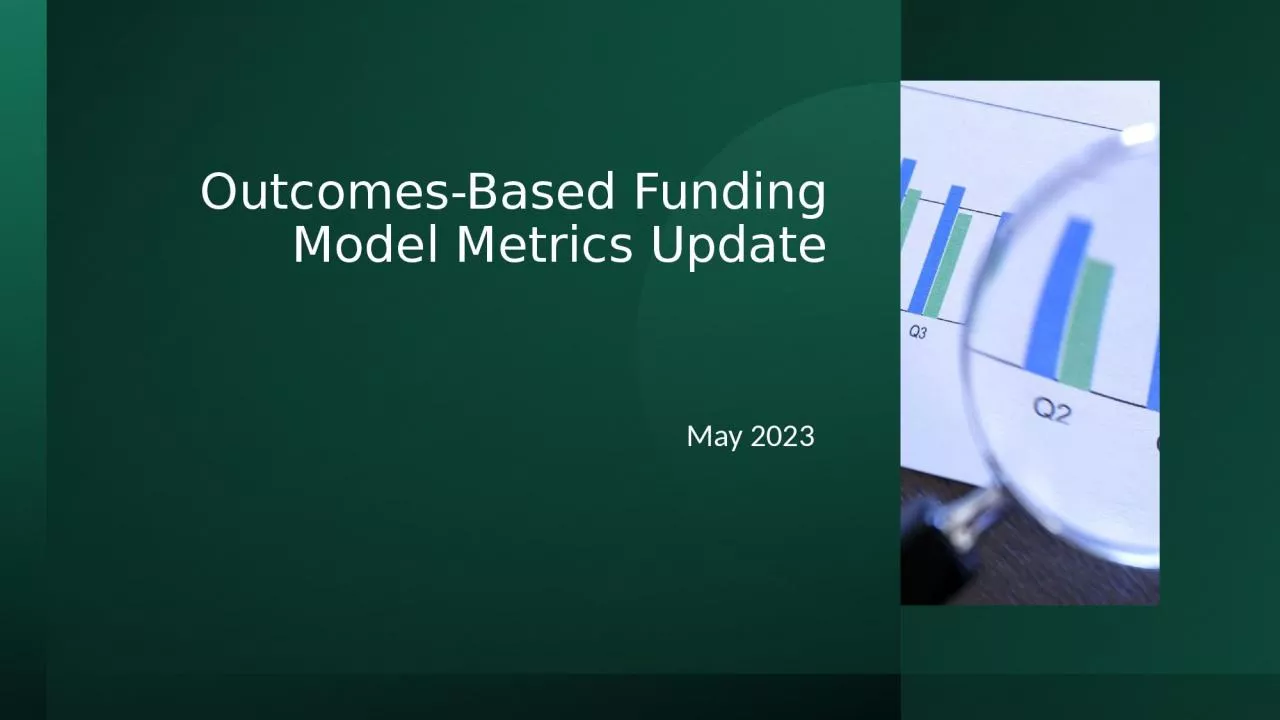

May 2023 What is OutcomesBased Funding Model OBFM Also called Performance Funding Model Initiated by the VCCS in 2015 Aligned financial policies with strategic goals Designed to encourage and recognize improved student outcomes ID: 1044215
Download Presentation The PPT/PDF document "Outcomes-Based Funding Model Metrics Upd..." is the property of its rightful owner. Permission is granted to download and print the materials on this web site for personal, non-commercial use only, and to display it on your personal computer provided you do not modify the materials and that you retain all copyright notices contained in the materials. By downloading content from our website, you accept the terms of this agreement.
1. Outcomes-Based Funding Model Metrics UpdateMay 2023
2. What is Outcomes-Based Funding Model (OBFM)?Also called Performance Funding ModelInitiated by the VCCS in 2015Aligned financial policies with strategic goalsDesigned to encourage and recognize improved student outcomes20% of state allocationDistributed to each college based on percentage of total points earned for measuresNo efficiency factor
3. Outcomes-based Funding Measures are classified into three major categories:
4. Successful Completion of College-Level Math and English Cohort of Associates-degree seeking students Entered VCCS colleges for the first time in Summer or FallCompletes the course with a C or betterCompletes the course within timeframe
5. Successful Completion of College-Level MathDecreased developmental students from 40% to 4% of entering cohort.Increased completion rate of developmental from 13% to 27%.Increased college-ready student cohort by 20%.Decreased completion rate of college-ready from 46% to 42%.Increased Math Completion Rate from 33% to 42%
6. Successful Completion of College-Level EnglishDecreased developmental students from 12% to 3% of entering cohort.Increased completion rate of developmental from 33% to 52%.Increased college-ready student cohort from 88% to 97% of entering cohort.Decreased completion rate of college-ready from 64% to 62%.Increased English Completion Rate from 60% to 62% over baseline year.
7. Retention in Spring and FallDisaggregating data by entering student course load allows us to see the differences in pathways.
8. Retention in Spring and Fall for Full-time Smaller percentage of Fall 2021 cohort enrolled 12 or more hours than in Fall 2013.Fall-to-spring retention dropped from 87% to 83%.Fall-to-fall retention increased from 63% to 65%.
9. Retention in Spring and Fall for Part-time Larger percentage of Fall 2021 cohort enrolled less than 12 hours than in Fall 2013.Fall-to-spring retention increased slightly from 64% to 65%.Fall-to-fall retention increased from 43% to 48%.
10. Credit Hour ProgressionStudent can earn up to 0.5 point for earning 12 credit hours with a cumulative 2.0 GPA by end of first spring semester.Student can earn up to 0.5 point for earning 24 credit hours with a cumulative 2.0 GPA by end of first spring semester.Previously dual enrolled student credits are counted after student enrolls as a regular student.
11. Credit Hour Progression57% of Fall 2020 cohort earned 12 or more credit hours within two semesters compared to 47% in Fall 2012.52% of Fall 2020 cohort earned 24 or more credit hours within five semesters compared to 42% in Fall 2012.
12. Annual AwardsOnly one award per student per year can be counted.Encourages colleges to award when student completes requirements.Underserved students include first generation, minority race/ethnicity and Pell eligible.Awards earned by dual enrolled students included.General education certificates are excluded.
13. Annual AwardsDegrees and Certificates awarded increased by 2% in 2022 compared to 2014. Certificates and CSCs awarded increased by 7%.Awards to underserved populations increased slightly in 2022 compared to 2014.
14. TransfersIdentified in National Student Clearinghouse data as not attending a VCCS college at that time, program –enrolled or dual-enrolled during the preceding academic year.Transfers must earn bachelor’s degree within 6 years of initial enrollment in the VCCS.
15. Transfers20% increase in transfers since baseline year.11% increase in transfers with 16 or more credits.17% increase in transfers with associates degree.
16. Transfers Earning Bachelor’s Degree17% increase in students earning a Bachelor’s degree within 6 years after entering a VCCS college.23% increase in students earning 16 or more credits at VCCS prior to earning a Bachelor’s degree.
17. For Further Inquiries Into the Outcomes-Based Funding ModelDisaggregated VCCS system data can be found within the Opportunity 2027 Strategic Plan dashboard on the vccs.edu website here.College-level data may be granted upon request at info@vccs.edu